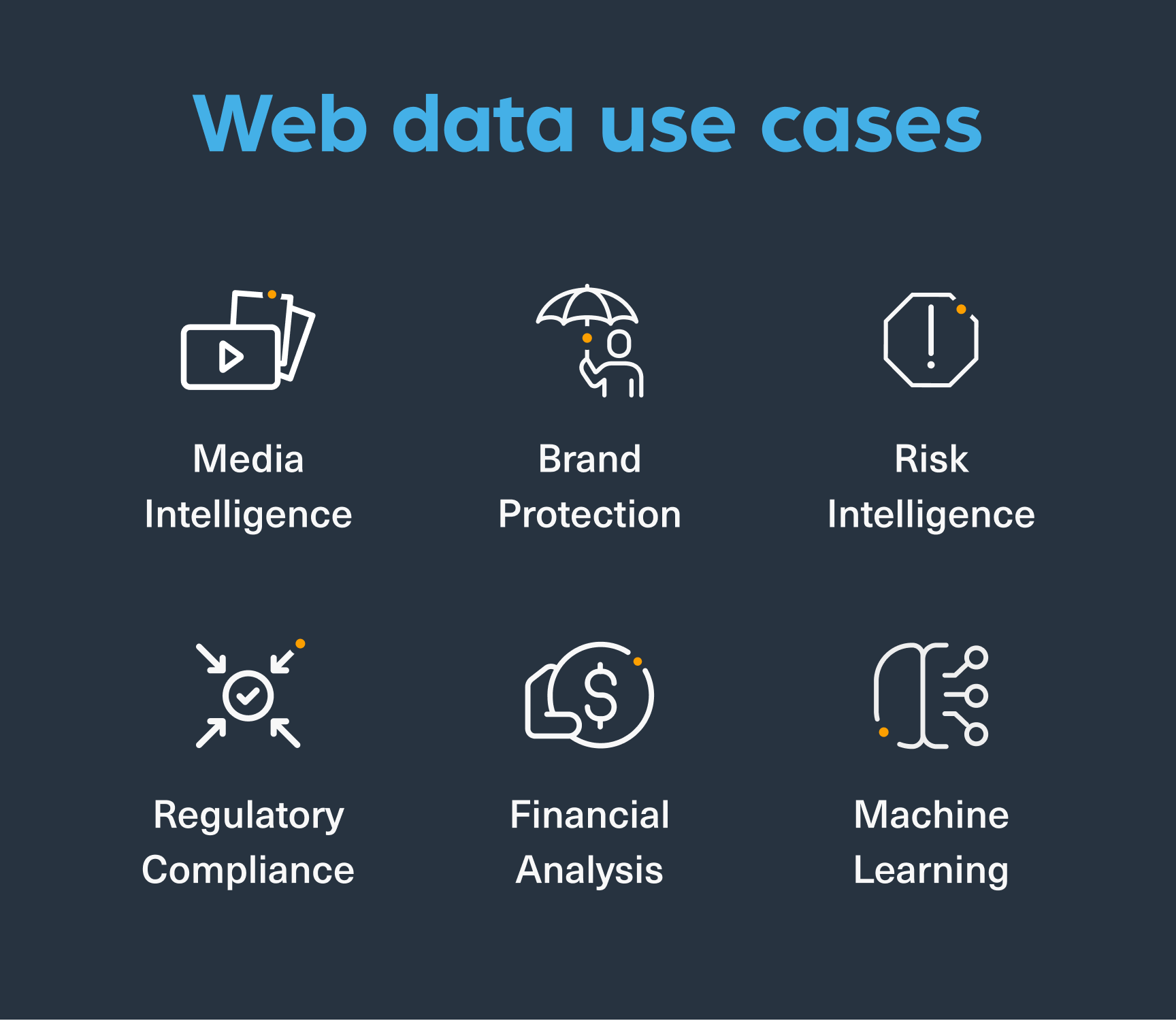Every team in your business needs fast and accurate insights to make decisions that will help the company succeed. For this reason, companies across industries — from media intelligence to risk management — have turned to web data integration platforms for automated insights. These platforms require a lot of data, especially web data, to perform well. We’ve created this guide to explain what web data is, the use cases for it, and the web data options available today.
What is web data?
Web data is information sourced and structured from various sites across the Internet. Types of web data include:
- Open web data – Publicly accessible data extracted from sources on the open web, such as news sites, blogs, message boards, forums, review sites, and Q&A pages.
- Dark web data – Data obtained from websites within a hidden network, or “Dark Web,” only accessible with a specially designed web browser like TOR. Dark web data includes posts that include leaked or stolen sensitive information, such as credit card numbers, social security numbers, and passwords.
- Deep web data – Data found on sites that traditional search engines do not index and password-protected sources. These sites live on networks such as Telegram and IRC.
We often see confusion around the terms “dark web data” and “deep web data,” so we’ve created an article to explain the differences between these two terms. You can use one or multiple types of web data to gain valuable insights for your business.
Web data use cases
You can use web data for a wide range of use cases, such as:
- Media Intelligence – By monitoring trends across millions of open web data sources, you gain real-time insights into consumer sentiment and industry trends. You can track content performance, brand sentiment, customer experience, and competitor performance.
- Brand Protection – Brands face many online threats today — from inflammatory comments made against them on alternative media sites to malicious insiders selling sensitive company information to third parties. You can uncover these threats by analyzing massive volumes of open, dark, and deep web data.
- Risk Intelligence — Every company today faces a wide range of constantly evolving risks. For example, supply chains can quickly become vulnerable to potential cybersecurity attacks. When corporate executives travel abroad, they face potential safety hazards stemming from crime, terrorism, or natural disasters. Brands face continuous attempts at counterfeiting and unlicensed use of their products. You can use open, deep, and dark data to create more accurate and effective risk assessment solutions.
- Regulatory Compliance — Running a business requires that you manage regulatory compliance well or face potentially huge penalties and fines. Every company faces different regulations depending on the geographic location in which the business operates. Companies also face an increasing number of government regulations. You need access to relevant public government websites to keep up with the latest regulations to ensure your business always remains in compliance.
- Financial Analysis – traditional web data and alternative data across the web contain hidden signals that impact financial markets and investments. You can discover consumer sentiment and economic trends by analyzing critical real-time and historical market information. You can then use that information to create data-driven investment strategies, accurate predictive financial models, and ESG benchmarking solutions.
- Machine Learning — You need high-quality data to build accurate and effective ML models, which typically requires data scientists to spend a lot of time on data cleaning and preparation. Using well-structured and unified web data helps reduce the time data scientists must spend on these tasks. And for certain types of machine learning, like supervised learning, you need quality historical web data to properly train predictive models.
Whatever the use case, you first need to find an efficient and cost-effective way to obtain relevant web data.

Key web data challenges
One of the most difficult challenges for businesses wanting to leverage web data is figuring out how to obtain it. Plus, many companies lack the skills and literacy necessary to use web data effectively. Gartner predicts that through 2025 most chief data officers will fail to promote the required data literacy among teams to achieve specific data-driven goals within the business.
When it comes to getting web data, you have two options — build a web crawling solution in-house or buy a big web data solution from a third party.
The key difference between building and buying a web data solution involves the total cost of ownership. It takes more time and costs to build and maintain a solution in-house than buy one that has already been developed, tested, and proven effective at scale. If you buy a solution, you don’t have to incur the time and costs of development, maintenance, upgrades, computing power, and security. We discuss building vs. buying a solution in depth in this white paper.
Web data solutions
If you want to buy a web data solution, you have two types to choose from: ad-hoc web scraping or web data feeds via APIs. The solution that will work best for you depends on how much data and scalability you need. For example, a large enterprise would need to leverage massive volumes of web data from different sources. In general, ad-hoc web scraping solutions are designed for small-scale data projects. The ad-hoc solution provides web data based on a list of websites the customer has given the data provider.
On the other hand, a solution that uses high-speed web feeds with flows of different data types would work well for the enterprise. Web data feeds provided through APIs allow businesses to access ongoing scalable flows of web data from numerous websites. They enable companies to generate insights from web data at scale.
Ad-Hoc Web Scraping vs. Web Data Feeds (APIs)
| Ad-Hoc Web Scraping | Web Data Feeds (APIs) | |
| Product | Largely DIY – You create a list of preferred data sources | Out of the box — Data feeds already made |
| Types of Data | Data typically from databases that store files with information from different sources, such as websites, emails, and invoices | Feeds from the open, deep, and dark web |
| Data Formats | Content not unified | Unified content (e.g., unified dates, timestamps) |
| Delivery | Ad-hoc | Ongoing |
| Search Option | Custom fields | Predefined structure |
| Scalability | Small scale (not many sites) — data scraped based on a predefined list of specific databases, URLs, or reports | At scale — Unlimited feed of web data generated by queries (e.g., keywords, categories, locations) |
| Management | Typically requires developers to manage lists of crawled websites and maintain the scraping tools | Comes in the form of easy-to-use APIs, so developers don’t have to maintain the solution |
| Machine Learning | Web scraped data often requires manual preparation and normalization for use in ML models | Provides high-quality, structured data, making it easier to automate data preparation and normalization |
Webz.io products
The Webz.io platform gathers data from sources across the open, dark, and deep web. We provide this data in the form of feeds which you can integrate into other platforms using our data feed APIs. Our web data feeds allow platforms to generate relevant insights at scale. Here are brief overviews of our API products:
Open web APIs
- News API — Use this feed for media monitoring, risk intelligence, financial analysis, and upgrading ML models. The feed collects data from millions of daily news articles and includes smart entities like sentiment and type. It contains news sources going back to 2008 in 170+ languages. This API uses an Adaptive Crawler, a unique technology we’ve developed that has allowed us to double the number of news articles we gather daily.
- Blogs API — This feed works well for market research, financial analysis, and media monitoring. It provides fresh data from blogs worldwide, enriching it with smart entities, sentiment, and categories. The data provided goes back to 2008 and is available in 170+ languages.
- Forums API — Get relevant contextual information for risk intelligence, financial intelligence, media monitoring, and market research. The feed crawls millions of posts daily that go back to 2008. You get data from forums across the globe in 170+ languages.
- Reviews API — An ideal web data feed for product management, upgrading ML models, financial analysis, and media monitoring. Every day the feed crawls review sites worldwide in multiple languages. It also provides reviews going back 13 years.
- Gov Data API — Use this feed to identify third-party and supply chain risks, ensure regulatory compliance, perform watchlist screening, and more. It provides global governmental data going back for at least five years. Data available includes governmental regulations, enforcement, ESG data, sanction lists, and corporate filings.
- Archived Web Data API — This feed is ideal for media monitoring, financial analysis, and creating powerful ML models. Access historical data from news, blogs, online forums, and reviews across the web. Data goes back to 2008.
Dark and deep web APIs
- Dark Web API — Use this data feed for brand protection, fraud detection, digital risk protection, web intelligence, and more. The feed crawls sites on the deep and dark web, extracting encrypted and password-protected content. It also tracks extremist social media posts and hacking posts.
- Data Breach Detection API — This data feed is ideal for brand protection, fraud protection, and VIP protection. Discover leaked data passed around sites on the deep and dark web. The feed crawls sites indexed by attributes such as email, credit card, domain, BIN, and SSN.
The future of web data
Today, web data plays a vital role in decision-making and risk protection for many businesses. But what does the future look like for web data as a whole? In the future, we expect to see the following:
- More annotated web data — More annotated data means that search engines and scraping/crawling solutions will better “understand” the meaning of the data, i.e., its structure for analysis.
- The fusion of web data types — We expect more companies to leverage multiple data types. For example, a company might extract data from news, government, and dark web sites, as one contributes to the other. Analyzing multiple data types adds more dimensions to analysis and brings deeper insights.
- More scraping prevention measures — We predict that more companies will implement measures to protect against illegal scraping. In the future, we expect that fewer reputable sites will be available for scraping, and some web data solutions will resort to evasive scraping techniques, like proxies.
How companies use web data will continue to evolve, and so will solutions for obtaining it.
Want to learn more about how to use web data effectively? Contact us today to talk with one of our data experts.




